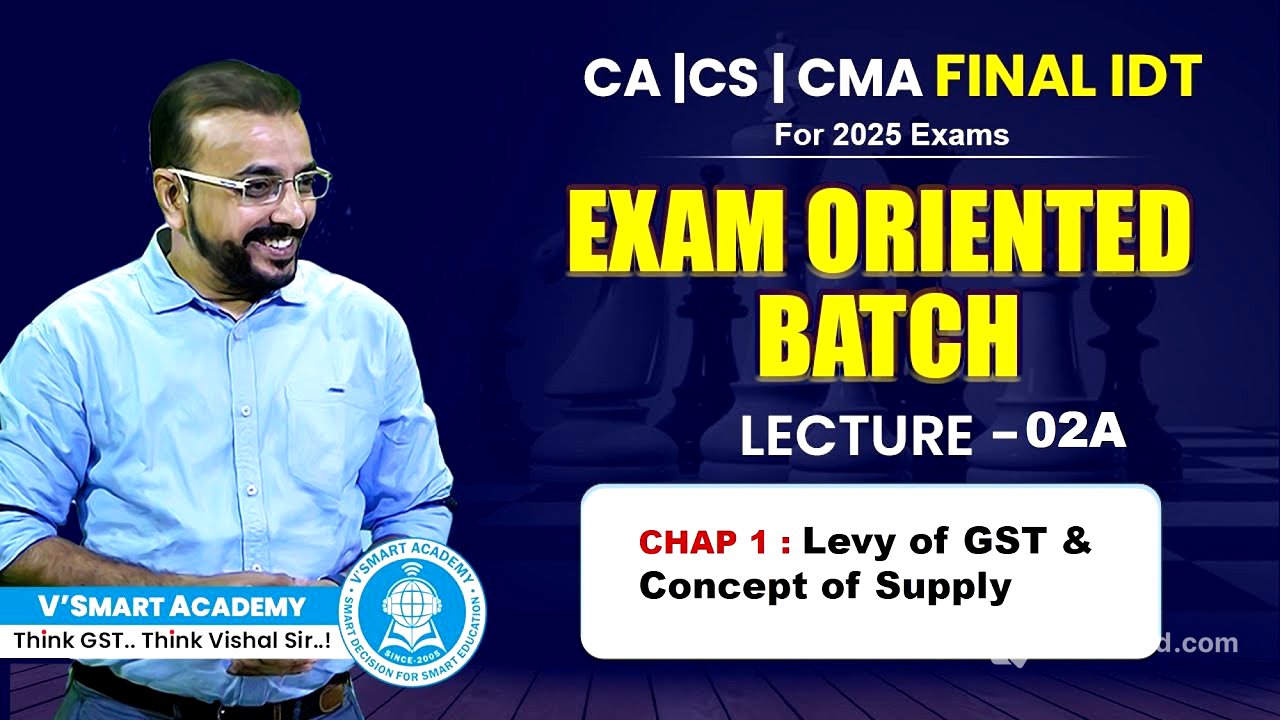TLDR;
This video provides a detailed explanation of GST concepts, including the basic principles, constitutional aspects, and definitions of key terms. It covers the five acts of GST, destination-based tax principles, and the role of Article 366. The video also discusses goods and services subject to GST, the GST Council's recommendations, and how to utilize IGST credit. Additionally, it explains the charging sections under CGST and IGST, differentiating between intrastate and interstate supplies, and the treatment of imported goods and services. The concept of supply, including taxable and non-taxable supplies, is thoroughly explained with definitions of person, taxable person, supplier, and recipient.
- Basic principles of GST and its constitutional aspects.
- Key definitions: person, taxable person, supplier, recipient.
- Differentiating between intrastate and interstate supplies.
- Treatment of imported goods and services under GST.
- Concept of supply, including taxable and non-taxable supplies.
Introduction [0:05]
The session begins with a positive affirmation, emphasizing that whatever has happened was good, and whatever will happen will be very good. The instructor sets the expectation for high energy and aims for students to score above 80 in IDT (Indirect Tax). The session will cover the basic concepts of GST, including revisions and discussions, focusing on chart-based learning.
Basic Concepts of GST [1:17]
The fundamental concepts of GST are outlined, including the five main acts: CGST, SGST, UTGST, IGST, and GST Compensation Cess. GST is a destination-based tax, paid at multiple stages based on VAT principles. The tax burden is ultimately borne by the end consumer, with suppliers receiving credit for purchases in B2B transactions until the goods reach the final consumer. Article 366 defines GST as a tax on goods and services, excluding alcoholic liquor for human consumption. Article 246A is the constitutional source for levying and collecting GST, granting concurrent power to both Parliament and state legislatures. The central government collects IGST, which is later allocated to the destination state. Key benefits of GST include creating a unified national market, mitigating the cascading effect of taxes, promoting the Make in India initiative, and increasing overall government revenue.
Goods Subject to GST and Excise [3:42]
The discussion covers which goods are subject to GST and excise duties. Petroleum products and alcoholic liquor for human consumption are not currently under GST. Petroleum products are subject to central excise, VAT, and CST, while alcoholic liquor is subject to state excise, VAT, and CST. Tobacco products are subject to GST plus central excise, and OPM (opium, Indian hemp, narcotics) is subject to GST plus state excise. All other products are subject to GST. Entertainment tax levied by local bodies is charged separately and added for GST calculation. Various central and state taxes, including excise duties, service tax, VAT, sales tax, and luxury tax, have been subsumed into GST. Property tax, stamp duty, electricity duty, basic custom duty, and excise duty on alcohol remain separate.
GST Council Recommendations and IGST Credit Utilization [6:46]
The GST Council can recommend taxes, exemptions, the structure of GST law, IGST apportionment, basic threshold limits, and GST rates. Special category states, including Arunachal Pradesh, Assam, Jammu & Kashmir, Manipur, Meghalaya, Mizoram, Nagaland, Sikkim, Tripura, Himachal Pradesh, and Uttarakhand, require GST Council recommendations for any extra tax implementation. IGST credit is utilized first against IGST, then CGST and SGST in any proportion. Cross credit of CGST and SGST is not allowed.
Union Territory GST and Charging Sections [8:27]
Delhi and Puducherry, which have state legislatures, are considered states for GST purposes. Intra-state sales in these territories are subject to CGST and SGST. Section 9(1) of the CGST and IGST Acts, the charging section, is divided into three parts: levy, collection, and person liable to pay. The levy includes charge (intrastate CGST and SGST, interstate IGST), valuation (as determined under Section 15 of the CGST Act), and rate (maximum 20% + 20%, i.e., 40%). GST rates are notified based on the GST Council's recommendations. Collection is done in a prescribed manner, and the taxable person is liable to pay.
Goods Not Subject to GST and Definition of India [12:53]
Goods not subject to GST include alcoholic liquor for human consumption and denatured spirit used in manufacturing alcohol. GST will not be levied on denatured extra neutral alcohol or spirit used in the manufacturing of alcohol. The definition of India includes the territory of India, states, UTs, land, water (territorial waters, seabed, and soil), continental shelf, exclusive economic zone, and maritime zones.
Section 9 Analysis and Intrastate vs. Interstate Supply [15:57]
Section 9 excludes alcoholic liquor from supply, with collection to be done in a prescribed manner by the taxable person. Valuation is based on Section 15. Intrastate supply occurs when the location of the supplier (LOS) and place of supply (POS) are in the same state or UT. Interstate supply occurs when LOS and POS are in different states or UTs. The IGST Act, specifically sections 10, 11, 12, and 13, determines the place of supply.
Tax Invoice and Place of Supply [19:09]
A tax invoice includes supplier details (GSTN, address) and recipient details (name, address, GSTN). The place of supply is fixed according to IGST Act sections 10, 11, 12, and 13, determining whether the supply is intrastate or interstate. The location of the supplier and place of supply are critical in determining this.
Interstate Supply and GST on Imported Goods [21:32]
Interstate supply occurs when the location of the supplier and the place of supply are in different states or UTs. Import of goods and services is also considered interstate supply. GST on imported goods involves two factors: imported goods and imported services. Imported goods are subject to Basic Custom Duty (BCD) and IGST under the Customs Act, referred to as Additional Customs Duty (ACD). Imported services are subject to GST under the IGST Act and are considered interstate.
Zero-Rated Supply and Export Benefits [25:01]
Export is considered an interstate supply under Section 7(5) of the IGST Act, but the government provides benefits through zero-rated supply. Zero-rated supply allows export without IGST payment, subject to certain conditions. This includes export of goods, export of services, and authorized operations to special economic zones (SEZ) or units. The government promotes exports by offering these concessions to maintain international market competitiveness.
Supply to SEZ and Pictorial Presentation [27:06]
Supplies to SEZ units or developers are also brought under the zero-rated benefit. SEZs are created to provide infrastructure, subsidies, and treat the area as a separate island for export-oriented manufacturing and services. Domestic companies supplying goods and services to SEZ units or developers are considered exports and receive zero-rated benefits if all conditions under the IGST Act are fulfilled. However, supplies by SEZ units are GST payable.
Concept of Supply and Key Definitions [30:41]
The concept of supply is discussed, including definitions from Section 2, Section 7 (supply), and Section 8 (composite and mixed supply). The discussion covers who the levy will fall on, how the collection will happen, and who will pay the tax. The law states that intrastate or interstate supplies are subject to GST. Key definitions include "person" (individual, HUF, company, firm, LLP, AOP, BOI, corporate body, cooperative society, local authority, government, society, trust, artificial judicial person) and "taxable person" (registered or liable to be registered under Section 22 or 24 of the CGST Act).
Taxable Person and GST Charges [34:16]
A taxable person is registered or liable to be registered under Section 22 or 24, meaning they have crossed the threshold or taken voluntary registration. GST applies to taxable persons. There are three charges in GST: forward charge (supplier pays tax), reverse charge (recipient pays tax), and electronic commerce operator (ECO) payment under Section 9(5).
Registered Person and Supplier Definitions [41:38]
A registered person is registered under Section 25 in form RG-01, excluding those with a unique identity number. A supplier is someone who supplies goods and services, including agents acting on the supplier's behalf. A provision has been added to include actionable claims, such as online money gaming and casinos, in the definition of goods. The supplier in online money gaming is the one who organizes and arranges the game directly or indirectly, or who owns, operates, and manages the digital electronic platform.
Recipient Definition and Chart Explanation [47:09]
The recipient is the person who pays consideration for the supply of goods and services. If there is no consideration, the recipient is the person to whom the goods are delivered or made available, or to whom the services are rendered. The agent of the recipient is also considered a recipient. The definition is divided into two parts: one for supplies with consideration and another for supplies without consideration.
Taxable vs. Non-Taxable Supplies and Exam Supplies [54:42]
Taxable supplies are subject to GST, while non-taxable supplies are not leviable to tax. Non-taxable supplies include petroleum products and alcoholic liquor for human consumption. Taxable supplies include those subject to GST, zero-rated supplies (export incentives), nil-rated supplies (subject to nil rate in GST tariff), and exempt supplies (subject to GST at normal rates but exempted by notification to promote socio-economic objectives). For GST purposes, nil-rated, exempt, and non-taxable supplies are treated as exempt supplies.
Goods and Services Definitions [1:09:26]
Goods mean any kind of movable property, while services mean anything other than goods. Money and securities are excluded from both goods and services. Goods include actionable claims and growing crops. Services include separate consideration charged for the use of money, conversion of money, and facilitating transactions in securities (e.g., brokerage). Interest charged on loans, advances, and deposits is a service, but the government has exempted interest on credit cards.
Specified Actionable Claims and Supply Definitions [1:21:30]
Specified actionable claims under Section 102A include betting, casinos, gambling, horse racing, lotteries, and online money gaming. The definition of a registered person includes those registered under Section 25, excluding those with a unique identity number. The concept of supply includes all forms of supply of goods and services, such as sale, transfer, barter, exchange, license, rental, lease, and disposal, made or agreed to be made for consideration in the course of business.
Section 7 Analysis: What Supply Includes and Excludes [1:28:20]
Section 7 is divided into two parts: what supply includes (Section 7(1)) and what supply excludes (Section 7(2)). Section 7(1) is further divided into supplies with consideration (Section 7(1)(a) and 7(1)(b)) and supplies without consideration (Section 7(1)(c), Schedule I). Section 7(1)(a) includes all forms of supply of goods and services, such as sale, transfer, barter, exchange, license, rental, lease, and disposal, made and agreed to be made for consideration in the course of business.









